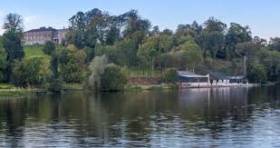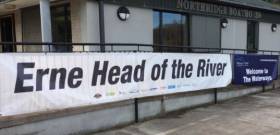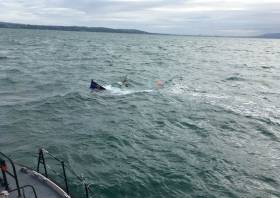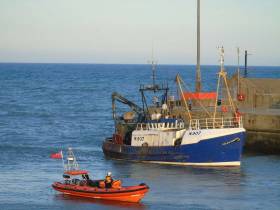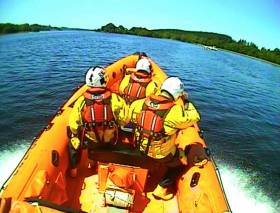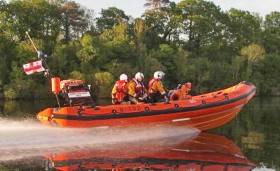Displaying items by tag: Enniskillen
#Rowing: The Afloat Rowers of the Month for April are the Enniskillen girls’ and boys’ junior 18 eights which won at Commercial and Neptune regattas, respectively. The young women won the final race at Commercial, beating the hosts in a fine contest which drew the curtain on more than two days of action at Islandbridge. Enniskillen’s boys’ junior 18 eight had beaten Coláiste Iognáid at Neptune regatta on the Saturday.
Enniskillen’s fine run recently has included outstanding placings in the Schools’ Head of the River in London, where the girls placed fourth and the boys sixth – and sixth fastest overall.
Rower of the Month awards: The judging panel is made up of Liam Gorman, rowing correspondent of The Irish Times and David O'Brien, Editor of Afloat magazine. Monthly awards for achievements during the year will appear on afloat.ie. Keep a monthly eye on progress and watch our 2019 champions list grow.
UCD Women Win Close Eights Final at Neptune Regatta
#Rowing: Commercial and UCD took the senior eights titles at Neptune Regatta in different fashions. Trinity's women's eight led UCD passing the Neptune boat house, but UCD fought hard and passed their great rivals to win by a canvas. Commercial beat UCD by one a half lengths in the men’s race.
On a cool, sunny day, Enniskillen boys competed in numbers – their girls will take part in Sunday’s Commercial Regatta – and had a set of good wins, the pick of them being a three-length win over Colaiste Iognaid in the men’s junior 18 eight.
In a battle of two strong junior 18 quadruples, Three Castles beat Neptune, while Trinity won the club one eight, also beating the hosts.
Two Neptune men, twin brothers Ronan and Colum Brennan, fought it out in the men’s junior singles, with Ronan coming out on top.
Rhiannon O’Donoghue of Killorglin beat Commercial’s Katie Dolan in the women’s club one single – Dolan had earlier won the senior single.
Neptune Regatta, Islandbridge, Saturday (Selected Results)
Men
Eight, Sen: Commercial bt UCD 1 ½ l. Club One: Trinity bt Neptune 3l. Novice: UCD bt Trinity A canvas. Jun 18: Enniskillen bt Col Iognaid 3l. Jun 16: Col Iognaid bt Blackrock 3ft.
Four – Club One, coxed: Enniskillen bt Neptune Jun 18, coxed: Enniskillen B bt Enniskillen A 2½ l. Masters, coxed: Commercial, Belfast BC, Galway bt Neptune.
Sculling, Quadruple – Club Two, coxed: Fermoy A bt Neptune 1l. Jun 18: Three Castles bt Neptune. Jun 18, coxed: Enniskillen A bt Enniskillen B. Jun 16, coxed: Cork. Double – Jun 16: Athlone bt Neptune A. Single – Sen: New Ross (Kennell-Webb bt Portadown (Laivins). Club One: Enniskillen (N Timoney) bt Enniskillen (J McDade) easily. Club Two: Trinity (Dennis) bt Carlow (Bolton-Dowling) . Jun 18: Neptune (R Brennan) bt Neptune (C Brennan) easily. Jun 16: Carlow (D Nolan) bt Neptune (A Gillick) easily.
Women
Eight – Sen: UCD bt Trinity canvas. Club One: UCD A bt Neptune. Novice: Trinity A bt Neptune 3l. Jun 16: Castleconnell bt Methody easily. Masters (G) Old Collegians bt Commercial, Belfast BC, Galway. E: Tribesmen A bt Neptune.
Four – Sen, coxed: Killorglin bt Akademiska Roddforeningen 2l. Club One, coxed: Commercial bt UCD B. Jun 18: Col Iognaid bt Carlow easily.
Sculling, Quadruple – Club Two, coxed: Killorglin bt Trinity easily. Jun 18: Athlone bt Graiguenamanagh easily. Jun 16, coxed: Col Iognaid bt Castleconnell.
Double – Jun 16: Shannon A bt Clonmel 3l.
Single – Sen: Commercial (K Dolan) bt New Ross (L Brown) 4l. Club Two: Carlow (Egan) bt Commercial (Norinho) 3l. Jun 18: Commercial (Healy) bt Commercial (Maloney) 2l. Club One: Killorglin (R O’Donoghue) bt Commercial (K Dolan). Jun 16: Three Castles (O’Loughlin) bt Shannon (Hickey).
Enniskillen Shine at Schools' Head of the River in London
#Rowing: Enniskillen’s girls’ and boys’ eights both shone at the Schools’ Head of the River in London today. Strong, gusting winds made conditions difficult – the numbers allowed to compete were cut because of this – but the Enniskillen RBC girls’ championship eight took fourth, while the boys’ championship eight were sixth. The boys’ crew placed sixth overall, 32.8 seconds behind the winners, Shiplake College.
Schools’ Head of the River, London (Irish interest)
Boys – Overall: 1 Shiplake College A Boys’ Championship Eight 16 min 36.6 seconds; 6 Enniskillen RBC Championship Eight 17:09.4.
Girls – Championship Eight: 1 Henley RC 18:44.2; 4 Enniskillen RBC 18:57.9.
Erne Head of the River to Go Ahead
#Rowing: Erne Head of the River, set for Enniskillen on Saturday (March 2nd), will go ahead. The organisers expect strong winds for the six kilometre event. They have told clubs to instruct their rowers to wear warm clothing. The head is set for 2pm.
Bangor & Donaghadee Lifeboats Launch To Fishing Boat On Rocks
#RNLI - Two RNLI lifeboats were launched on Friday (31 August) at the request of Belfast Coastguard to assist a pleasure fishing boat with four people onboard off Carrickfergus.
Bangor RNLI was first to launch at 3.15pm to reports that a fishing boat had a fouled propeller and was taking on water while drifting ashore onto rocks near Carrickfergus.
Once on scene, the Bangor lifeboat crew established a towline and were able to pull the sinking boat off the rocks, as well as transfer two of its crew to the safety of the inshore lifeboat Jessie Hillyard, where they were given casualty care.
The remaining two fishermen were recovered on the shoreline by coastguard members.
Due to the vessel taking on too much water, the decision was taken to request the assistance of Donaghadee RNLI’s all-weather lifeboat and use its salvage pump to try and save the vessel.
Bangor cut their towline and proceeded to take the two casualties, who were wet and cold, to Carrickfergus and the care of the waiting coastguard crew.
Donaghadee’s volunteers were paged at 4.12pm and proceeded on their lifeboat Saxon at full speed to the last reported location of the sinking vessel.
Upon arrival, the fishing boat was already semi submerged and in the shipping lane, posing a danger to shipping traffic and local boats.
The crew were able to secure a line and tow the boat to shallow waters just north-east of Carrickfergus and prevent it becoming a danger to other boats. Unfortunately, the boat was unable to be recovered.
Speaking after the dual operation, Donaghadee RNLI coxswain Philip McNamara said: “Although unable to make it on time to save the fishing boat, the main concern is the safety of the crew members onboard. Thankfully the speedy response of our colleagues in Bangor ensured the people were brought to safety before the situation deteriorated any further.
“The crew member that requested assistance as soon as they realised they were in trouble did the right thing; the two crew members that made it ashore were very lucky to do so. If in difficulties it can be best to stay with your vessel as long as possible and avoid entering the water if you can.”
In other RNLI news from Northern Ireland, young members of Lough Erne Yacht Club went the extra mile for the lifesaving charity when they held a mini triathlon that raised £310 for Enniskillen Lifeboat Station, based at their club.
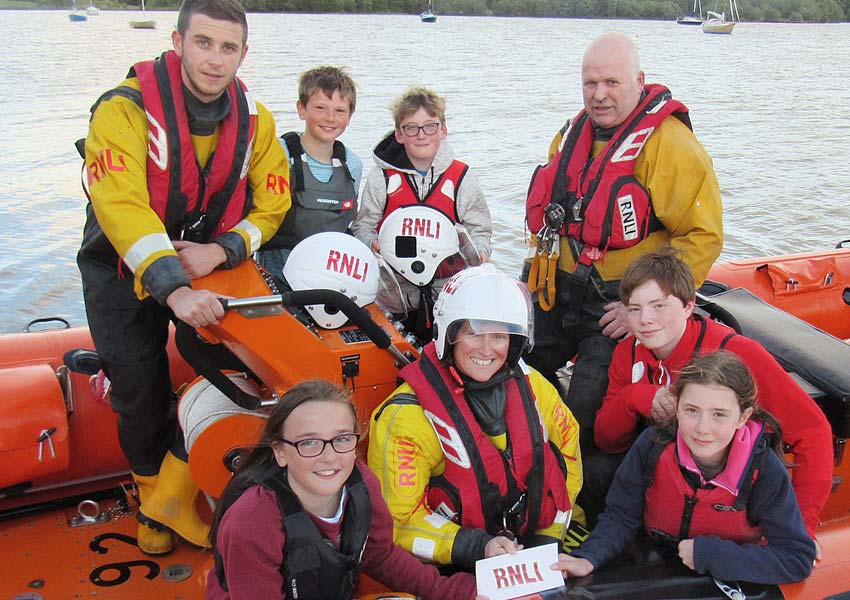
Emma Brines and Emily Torrens along with Peter Brines, Charlie Valentine and Adam Torrens presented the cheque to Lifeboat crew members Olivia Crosgrove, Padraig Lunny and helm Brian McAleer (photo by Bob Torrens). The young sailors thanked club members, family and friends for their support.
Kilkeel Lifeboat Launches To Fisherman Taken Ill
#RNLI - Kilkeel RNLI’s volunteer crew launched their inshore lifeboat at 7.55pm yesterday evening (Thursday 26 July) after a crew member of a fishing boat was reported unwell and in need of medical attention.
Winds were blowing 3 to 4 knots with a choppy sea and good light as the lifeboat headed to the fishing vessel four miles south-east of Kilkeel Harbour.
On reaching the fishing boat, two lifeboat crew members went aboard to access the casualty, who was a diabetic and unconscious.
The lifeboat crew made the casualty comfortable and administered oxygen while reassuring him that he would be fine.
Another crew member went aboard with a stretcher but with the choppy conditions, it was deemed too awkward to transfer the casualty to the lifeboat, so the three crew members remained with the casualty.
On entering the safety of the harbour, the casualty was finally transferred to the lifeboat and safely brought ashore to a waiting ambulance crew. The local coastguard was also in attendance.
Kilkeel RNLI lifeboat operations manager John Fisher said: “The crew performed, as always, in a professional and competent manner and the callout showed the value of keeping up-to-date with all first aid matters. And we are glad to know that the casualty is making a good recovery.”
Earlier in the day, Enniskillen RNLI was requested to launch by Belfast Coastguard at 12.36pm to a boat aground and reports of a person in the water in the Castle Cauldwell area.
The PSNI boat Lady Grey was also requested. Weather conditions at the time were clear and bright with a moderate wind.
Enniskillen’s volunteer crew on the inshore lifeboat Joseph and Mary Hiley and the rescue water craft made their way to the area and found all six people aboard the grounded 40ft cruiser — five adults and one child — were safe and well.
A tow was set up and the crew managed to free the vessel from the area into safer water. The lifeboat crew onboard checked the boat over and found it working well mechanically, and stayed with the cruiser’s crew until they were well into the Belleek River. The passengers were happy to make their onward journey.
“We would like to wish those onboard the cruiser a safe and enjoyable onward journey,” said Stephen Ingram, Enniskillen RNLI’s volunteer lifeboat press officer. “Today’s callout was a good example of ourselves and our colleagues in the local PSNI working well together to bring people to safety.
“As people continue to enjoy Lough Erne this summer, we would remind everyone to always respect the water. If your vessel does get into difficulty call 999 or 112 and ask for the coastguard.
“As the terrain underwater can be unpredictable we would ask people to always remain onboard your boat and wait for help to arrive.”
#Rowing: Commercial won a stunningly-close race to take the men’s senior eights title at the Irish Rowing Championships today. NUIG/Queen’s had a slight lead ahead of a tightly-packed field early on, but Commercial moved at the 1,000 metres. They could not shake off UCD and the NUIG/Queen’s composite. UCD
finished really fast and almost – but not quite – caught Commercial, who were taking their third consecutive title.
The women’s senior eight went to Skibbereen. Their talented crew, stroked by Denise Walsh, had a clearwater lead over NUIG, who did not give up the fight but finished second. Skibbereen lifted their title haul to eight with the win.
Enniskillen started the evening session with two wins, in the women’s club eight, where Shandon pushed them, and the men’s junior pair, who were imperious in their victory.
The women’s junior coxed quadruple from Workmen’s was similarly impressive – the quality of junior rowing was a remarkable aspect of this regatta.
Another notable aspect was the proportion of wins which went to Cork clubs. Two of the last three titles did not leave the rebel county: UCC finished out their successful programme with a win in the men’s intermediate double through Ronan Byrne and Hugh Sutton, while Selma Bouanane took the last race of the event, the women’s intermediate single, for Fermoy.
Irish Rowing Championships, Day Three (Selected Results)
Men
Eight – Senior: 1 Commercial (S Mac Eoin, C Cunningham, L Cameron, N Beggan, P Moreau, F Groome, M Corcoran, C Dowling; cox: M Crockett) 5:43.18, 2 UCD 5:43.76, 3 NUIG/Queen’s 5:46.82.
Four – Club, coxed: UCC A 6:38.03.
Pair – Inter: Shandon A 6:56.07. Junior: Enniskillen 6:56.199.
Sculling, Double – Inter: UCC 6:32.59. Junior: Castleconnell (R O’Neill, J Desmond) 6:49.97.
Lightweight Single: Skibbereen (A Burns) 7:20.56.
Women
Eight – Senior: 1 Skibbereen (L Heaphy, O Hayes, M Piggott, A McCarthy, N Long, N Casey, A Casey, D Walsh; cox: A O’Neill) 6:28.42, 2 NUIG A 6:33.32, 3 Trinity 6:48.35. Club: Enniskillen 6:48.33.
Four – Inter, coxed: Cork 7:22.36.
Pair – Junior: Fermoy (E O’Reilly, G McGirr) 7:48.69.
Sculling, Quadruple – Junior: Workmen’s 7:01.06.
Single – Inter: Fermoy (S Bouanane) 8:03.25.
Lightweight Single: 1 Lee (M Cremen) 8:06.97
Championship Records Tumble at National Rowing Centre
#Rowing: Records fell in race after race in the final Saturday session of the Irish Championships. The Skibbereen senior quadruple of Fintan McCarthy, Aodhan Burns, Kealan Mannix and Jake McCarthy smashed the Championship best of 5:59.10 as they won in 5:50.696.
The Shandon junior quadruple of Eoin Gaffney, Luke Hayes-Nally, Jack Dorney and Alex Byrne – all set to compete at the World Junior Championships – set a new time of 5:58.26. This beat the old Championship record of 6:07.97.
In both cases the crews were bettering times set by their own club.
Lisa Dilleen’s win in the women’s senior single scull was emphatic. The Cork Boat Club sculler set a Championship course record of 7:34.282, bettering Monika Dukarska’s time of 7:35.07.
Ronan Byrne of UCC took the intermediate single, under some pressure from Niall Beggan of Commercial. Byrne’s time of 6:55.898 bettered Kealan Mannix’s time of 7:03.51, set last year.
Enniskillen took the women’s junior eights, in 6:30.753, bettering their own time from last year of 6:36.24.
In the women’s senior pair, Aine McCarthy and Niamh Casey shattered the old Championship record of 7:23.78, setting a new time of 7:17.176.
Joan Poh of Neptune also won the club single sculls in a new record. The old figure was 8:09.22. Poh won in 8:06.13.
UCD continued their fine run in eights by adding the men’s novice title to the intermediate one.
Irish Championships, Day Two (Selected Results)
Men
Eight – Inter: UCD 5:43.70. Novice: UCD 6:03.599.
Four – Junior, coxed: Enniskillen 6:22.66.
Sculling, Quadruple – Senior: Skibbereen 5:50.696. Jun: 1 Shandon 5:58.26
Single – Inter: UCC (R Byrne) 6:55.898. Club: Carlow (F O’Driscoll) 7:25.3.
Women
Eight – Novice: Queen’s 7:04.49. Jun: Enniskillen 6:30.75.
Pair – Senior: Skibbereen 7:17.18.
Sculling, Double – Inter: Skibbereen 7:09.09. Single – Senior: Cork BC (L Dilleen) 7:34.28. Club: Neptune (J Poh) 8:06.1. Jun: Coleraine GS (M Curry) 7:53.46.
Enniskillen Lifeboat Rescues Two After Boat Fire
#RNLI - Enniskillen RNLI brought two people to safety on Wednesday afternoon (4 July) after their boat they were on showed signs of catching fire.
The two people on board quickly used their fire extinguishers while also phoning 999 to ask for the coastguard.
Belfast Coastguard quickly requested the launch of Enniskillen’s inshore lifeboat Joseph and Mary Hiley, which launched with the rescue water craft to the casualty vessel close to Castle Cauldwell, three miles east of Belleek in Co Fermanagh.
On arrival, Enniskillen RNLI were joined by a passing vessel offering assistance. Conditions at the time were warm and calm and no wind.
The volunteer crew checked that the casualty boat and the owners had extinguished the source of the fire and carried out necessary precautions.
The lifeboat set up a towline and brought the boat and passengers to Magho jetty, where they were met by Northern Ireland Fire and Rescue Service personnel based in Belleek. The boat was checked over again and all were satisfied that the fire was well extinguished.
Following the callout, Enniskillen RNLI helm Adrian Kelly said: “We were happy to assist the vessel back to Magho jetty after the owner had safely deployed his fire extinguishers and prevented serious damage.
“It was encouraging to see that the vessel had adequate safety equipment on board.”
Elsewhere, Dun Laoghaire RNLI responded to a jetskier when his engine failed in Scotsman’s Bay on Tuesday evening (3 July).
The request to launch came in at 7pm after a member of the public alerted the coastguard.
The lifeboat crew of three on Dun Laoghaire’s in-shore lifeboat successfully towed the jetskier safely back to Dun Laoghaire Harbour.
Commenting after the callout, Dun Laoghaire RNLI helm Alan Keville said: “‘It was great to see the jet skier was wearing a lifejacket but he had no means of alerting the coastguard himself. It is essential to always carry a means of communication.”
Enniskillen Lifeboat Rescues Two After Boat Breaks Free From Jetty During Storm Hector
#RNLI - Enniskillen RNLI rescued two people on Lower Lough Erne after their 42ft cruiser broke free from its jetty during Storm Hector yesterday morning (Thursday 14 June).
Belfast Coastguard requested the launch of the inshore lifeboat at 6.42am, with the volunteer crew proceeding north to the stricken vessel close to the shoreline south of Rossigh.
With increasing winds through the night, the vessel had broken free from its mooring and some of the jetty was still secured to the boat.
The winds were starting to settle but they were estimated to be Force 6 or 7 when launching from the Lough Erne Yacht Club.
The lifeboat managed to refloat the vessel and brought it into safer water. The hire company then took charge of the cruiser with the lifeboat accompanying them to a sheltered location.
“With challenging conditions this morning the crews training was put into action and brought the two people and vessel to safety,” said Gary Jones, Enniskillen RNLI’s lifeboat operations manager.
Elsewhere, pagers sounded across the Irish Sea at Holyhead RNLI just after midnight on Thursday in the midst of the storm, with reports of an 18-metre yacht with mechanical failure west of the Skerries lighthouse off Anglesey.
At the scene, the lifeboat crew found the 60-tonne vessel, with two on board, had lost all power and was struggling to cope with the weather conditions, including southerly gale-force winds and spring tides.
The lifeboat undertook a tow of the stricken yacht, which was returning from the Isle of Man TT races back to her mooring at Holyhead. Both vessels arrived safely in port at 4.30am.
Speaking on behalf of Holyhead RNLI, press officer Vicki Owens said: “The weather was unseasonably rough, but our dedicated crew left their beds to help someone in trouble.”
The surprise Storm Hector was also responsible for blowing a yacht ashore on the Kerry coast, as previously noted on Afloat.ie.


























